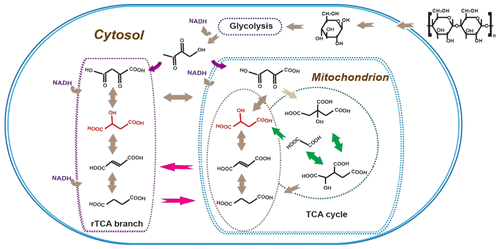当前位置:
X-MOL 学术
›
ACS Synth. Biol.
›
论文详情
Our official English website, www.x-mol.net, welcomes your feedback! (Note: you will need to create a separate account there.)
Synergistic Rewiring of Carbon Metabolism and Redox Metabolism in Cytoplasm and Mitochondria of Aspergillus oryzae for Increased l-Malate Production
ACS Synthetic Biology ( IF 4.7 ) Pub Date : 2018-08-09 00:00:00 , DOI: 10.1021/acssynbio.8b00130 Jingjing Liu 1, 2 , Jianghua Li 2 , Yanfeng Liu 1, 2 , Hyun-dong Shin 3 , Rodrigo Ledesma-Amaro 4 , Guocheng Du 1 , Jian Chen 2 , Long Liu 1, 2
ACS Synthetic Biology ( IF 4.7 ) Pub Date : 2018-08-09 00:00:00 , DOI: 10.1021/acssynbio.8b00130 Jingjing Liu 1, 2 , Jianghua Li 2 , Yanfeng Liu 1, 2 , Hyun-dong Shin 3 , Rodrigo Ledesma-Amaro 4 , Guocheng Du 1 , Jian Chen 2 , Long Liu 1, 2
Affiliation

|
l-Malate is an important platform chemical that has extensive applications in the food, feed, and wine industries. Here, we synergistically engineered the carbon metabolism and redox metabolism in the cytosol and mitochondria of a previously engineered Aspergillus oryzae to further improve the l-malate titer and decrease the byproduct succinate concentration. First, the accumulation of the intermediate pyruvate was eliminated by overexpressing a pyruvate carboxylase from Rhizopus oryzae in the cytosol and mitochondria of A. oryzae, and consequently, the l-malate titer increased 7.5%. Then, malate synthesis via glyoxylate bypass in the mitochondria was enhanced, and citrate synthase in the oxidative TCA cycle was downregulated by RNAi, enhancing the l-malate titer by 10.7%. Next, the exchange of byproducts (succinate and fumarate) between the cytosol and mitochondria was regulated by the expression of a dicarboxylate carrier Sfc1p from Saccharomyces cerevisiae in the mitochondria, which increased l-malate titer 3.5% and decreased succinate concentration 36.8%. Finally, an NADH oxidase from Lactococcus lactis was overexpressed to decrease the NADH/NAD+ ratio, and the engineered A. oryzae strain produced 117.2 g/L l-malate and 3.8 g/L succinate, with an l-malate yield of 0.9 g/g corn starch and a productivity of 1.17 g/L/h. Our results showed that synergistic engineering of the carbon and redox metabolisms in the cytosol and mitochondria of A. oryzae effectively increased the l-malate titer, while simultaneously decreasing the concentration of the byproduct succinate. The strategies used in our work may be useful for the metabolic engineering of fungi to produce other industrially important chemicals.
中文翻译:

稻米曲霉细胞质和线粒体中碳代谢和氧化还原代谢的协同更新,以提高l-苹果酸的产量
升苹果酸是一种重要的平台化合物具有在食品,饲料,酿酒等行业广泛应用。在这里,我们协同工程改造了以前设计的米曲霉的胞质和线粒体中的碳代谢和氧化还原代谢,以进一步改善l-苹果酸的滴度并降低副产物琥珀酸的浓度。首先,将中间丙酮酸的累积通过从过表达丙酮酸羧化酶消除米根霉在胞质溶胶和线粒体米曲霉,并且因此,升-苹果滴度增高7.5%。然后,苹果酸通过在线粒体乙醛酸旁路增强,并在氧化性TCA循环的柠檬酸合成酶是通过RNAi下调,提高升10.7% -苹果滴度。接下来,通过来自酿酒酵母的二羧酸盐载体Sfc1p在线粒体中的表达来调节细胞质和线粒体之间的副产物(琥珀酸盐和富马酸盐)的交换,其增加了1-苹果酸盐滴度3.5%并且降低了琥珀酸盐浓度36.8%。最后,从NADH氧化酶的乳酸乳球菌中过表达降低NADH / NAD +比值和工程改造的米曲霉菌株产生117.2克/ L升苹果酸和3.8 g / L的琥珀酸酯,与升0.9克/克的玉米淀粉-苹果产量和1.17克/升/小时的生产率。我们的结果表明,米曲霉细胞质和线粒体中碳和氧化还原代谢的协同工程有效提高了l-苹果酸的滴度,同时降低了副产物琥珀酸盐的浓度。我们的工作中使用的策略可能对真菌的代谢工程产生其他工业上重要的化学物质很有用。
更新日期:2018-08-09
中文翻译:

稻米曲霉细胞质和线粒体中碳代谢和氧化还原代谢的协同更新,以提高l-苹果酸的产量
升苹果酸是一种重要的平台化合物具有在食品,饲料,酿酒等行业广泛应用。在这里,我们协同工程改造了以前设计的米曲霉的胞质和线粒体中的碳代谢和氧化还原代谢,以进一步改善l-苹果酸的滴度并降低副产物琥珀酸的浓度。首先,将中间丙酮酸的累积通过从过表达丙酮酸羧化酶消除米根霉在胞质溶胶和线粒体米曲霉,并且因此,升-苹果滴度增高7.5%。然后,苹果酸通过在线粒体乙醛酸旁路增强,并在氧化性TCA循环的柠檬酸合成酶是通过RNAi下调,提高升10.7% -苹果滴度。接下来,通过来自酿酒酵母的二羧酸盐载体Sfc1p在线粒体中的表达来调节细胞质和线粒体之间的副产物(琥珀酸盐和富马酸盐)的交换,其增加了1-苹果酸盐滴度3.5%并且降低了琥珀酸盐浓度36.8%。最后,从NADH氧化酶的乳酸乳球菌中过表达降低NADH / NAD +比值和工程改造的米曲霉菌株产生117.2克/ L升苹果酸和3.8 g / L的琥珀酸酯,与升0.9克/克的玉米淀粉-苹果产量和1.17克/升/小时的生产率。我们的结果表明,米曲霉细胞质和线粒体中碳和氧化还原代谢的协同工程有效提高了l-苹果酸的滴度,同时降低了副产物琥珀酸盐的浓度。我们的工作中使用的策略可能对真菌的代谢工程产生其他工业上重要的化学物质很有用。



























 京公网安备 11010802027423号
京公网安备 11010802027423号